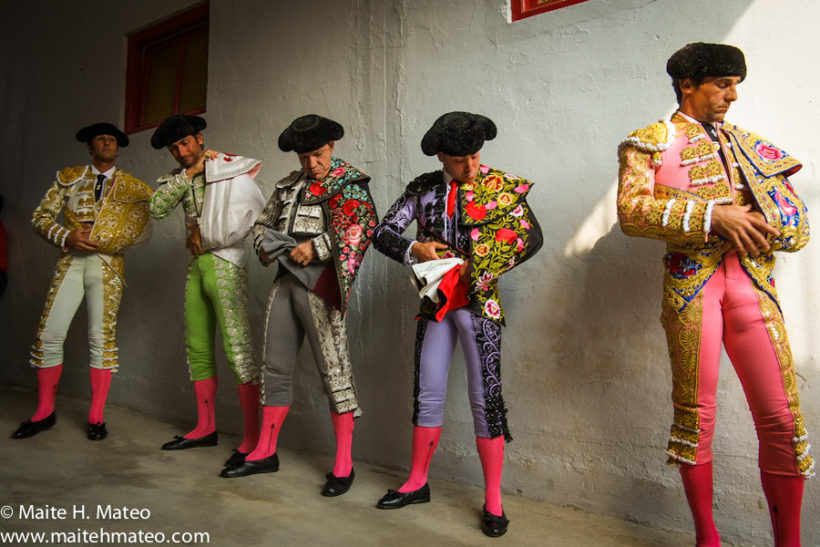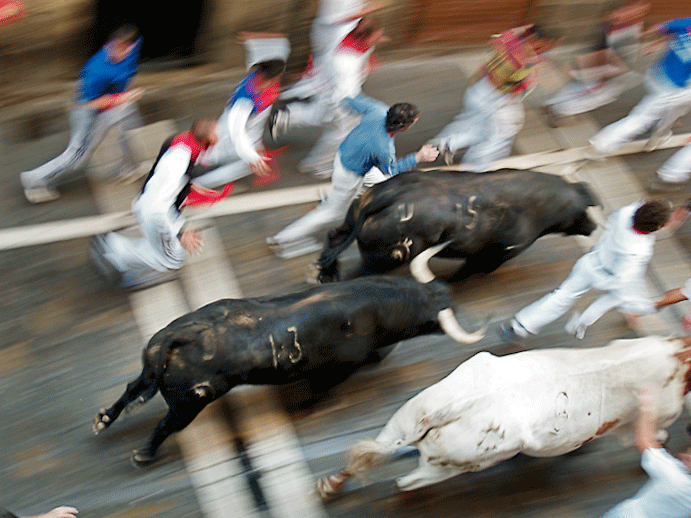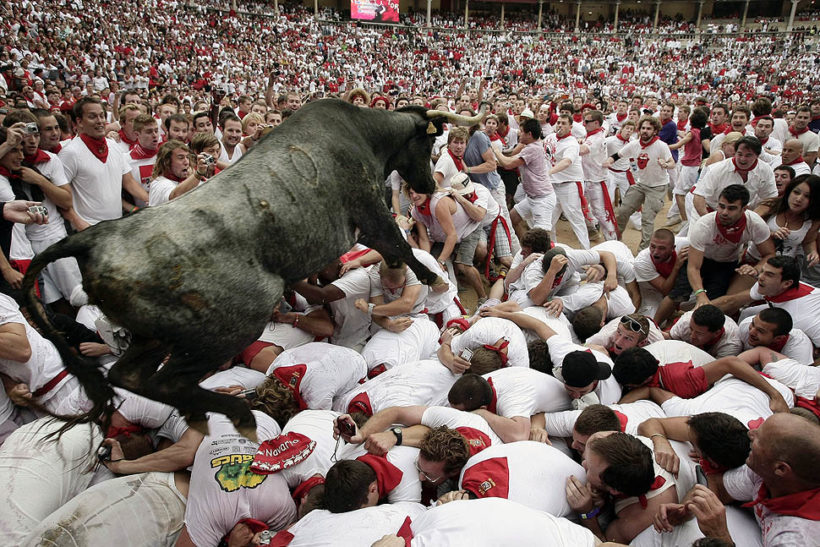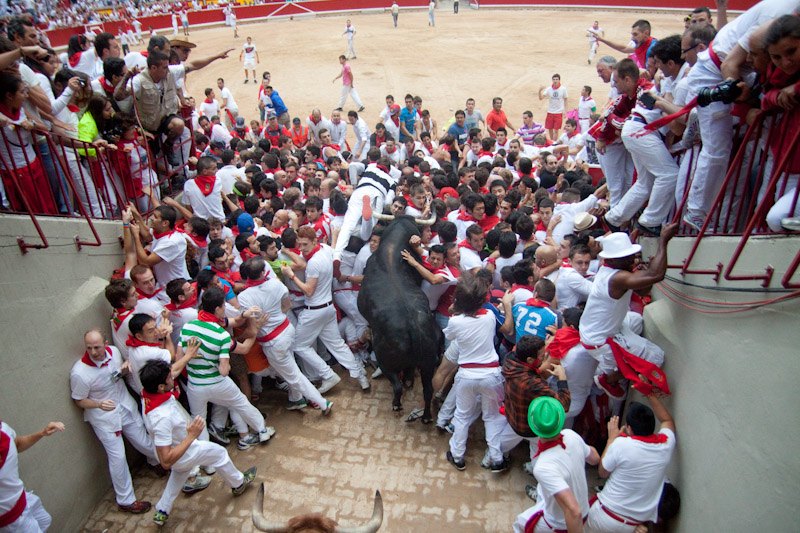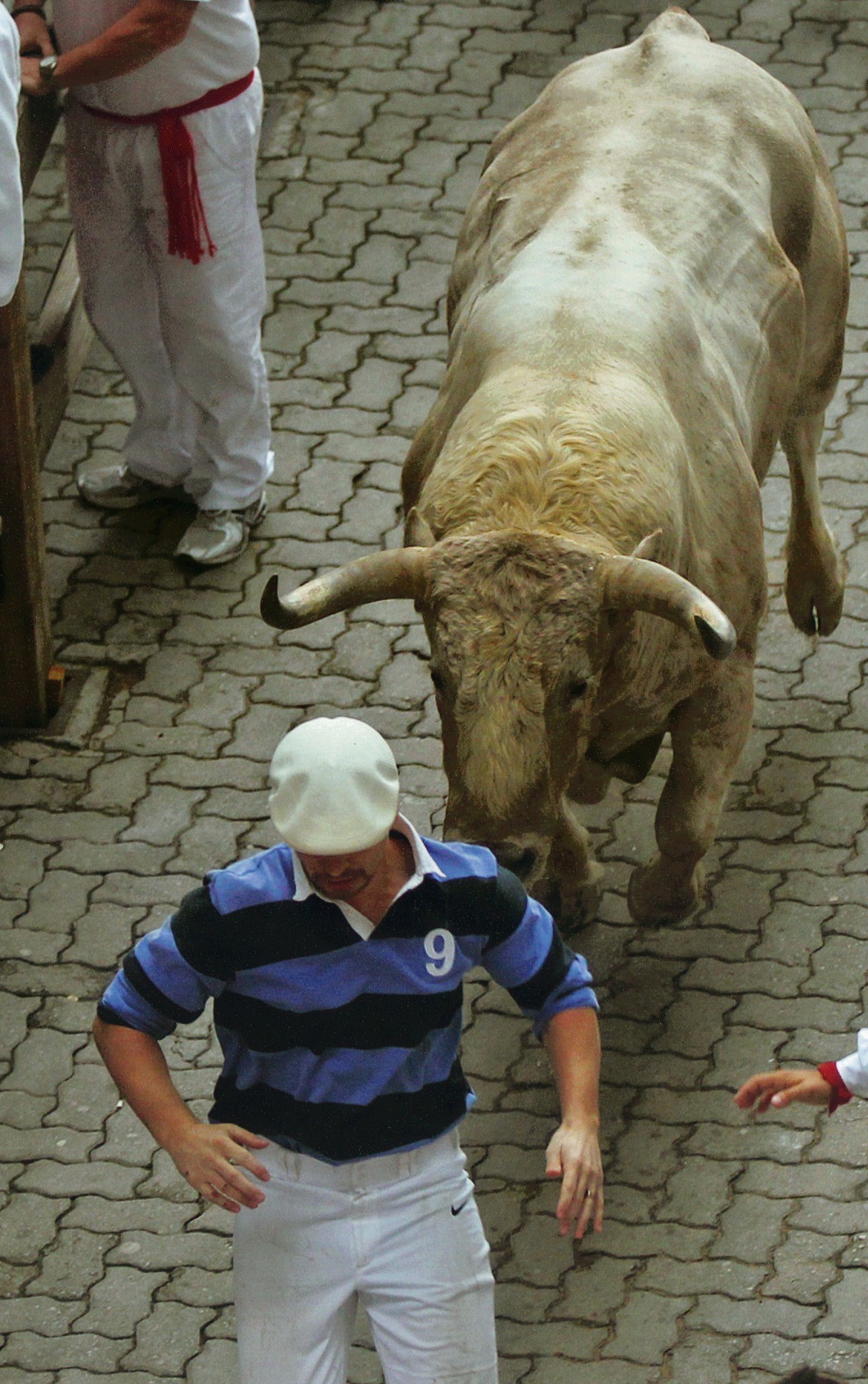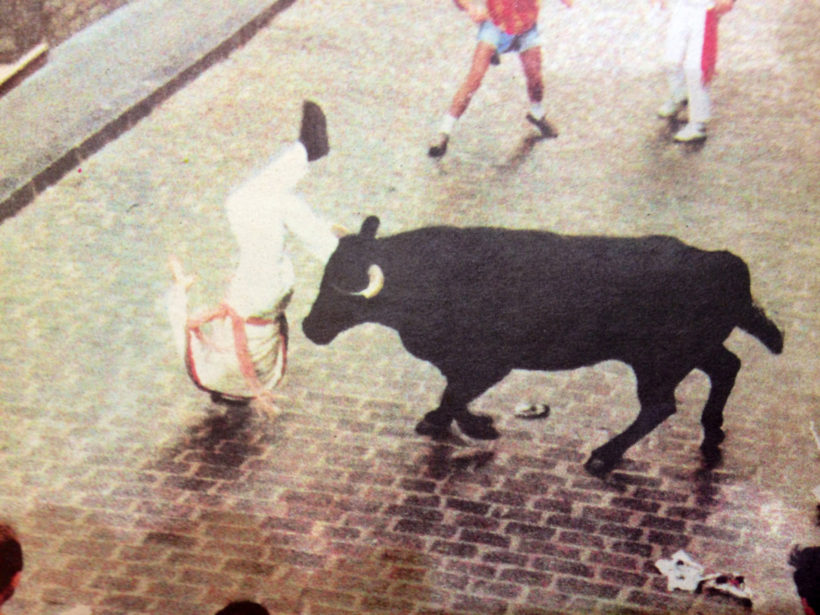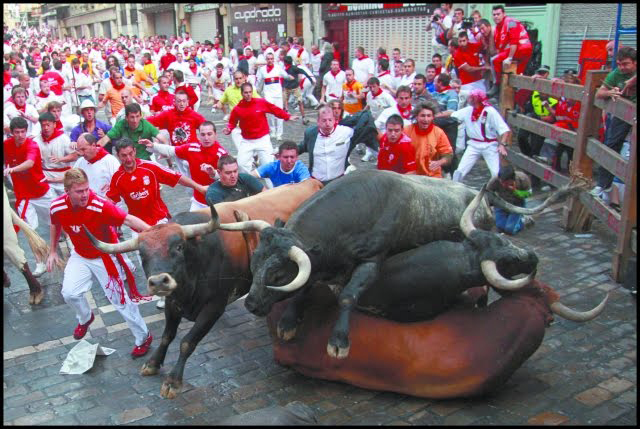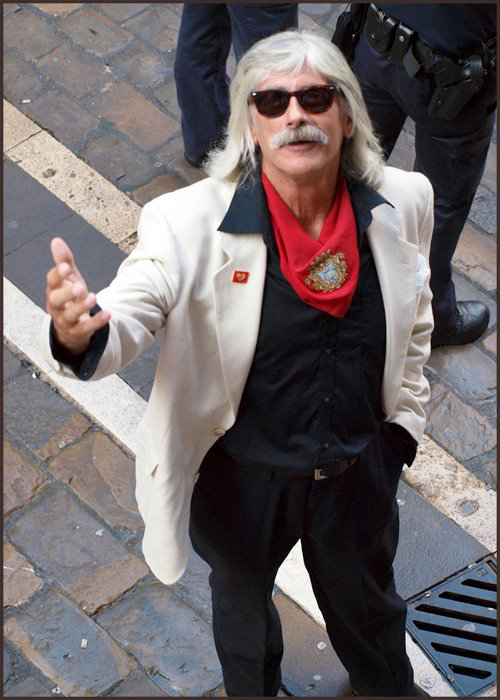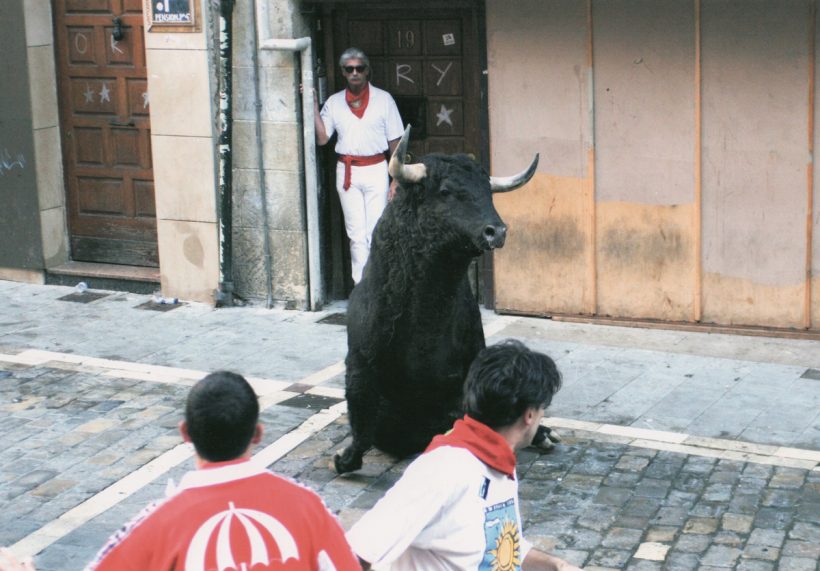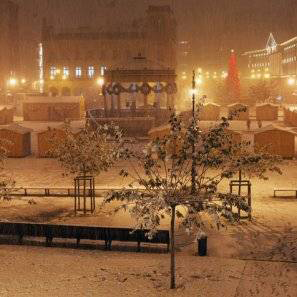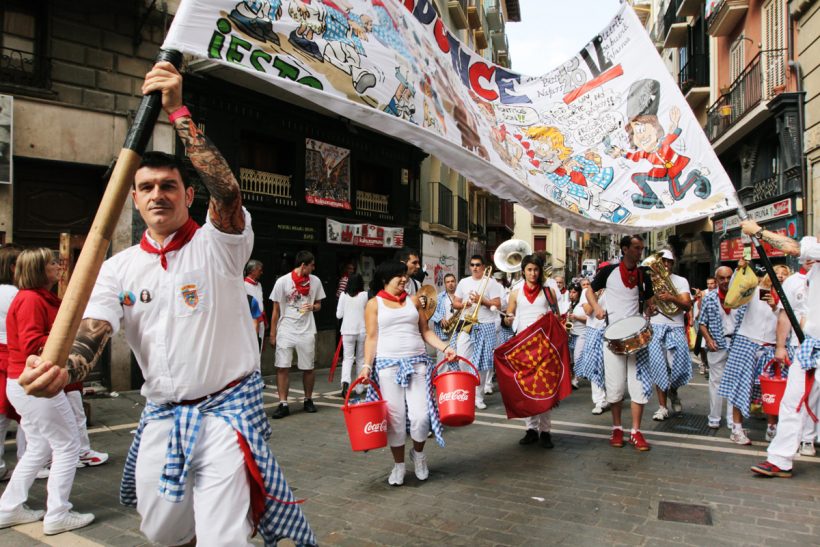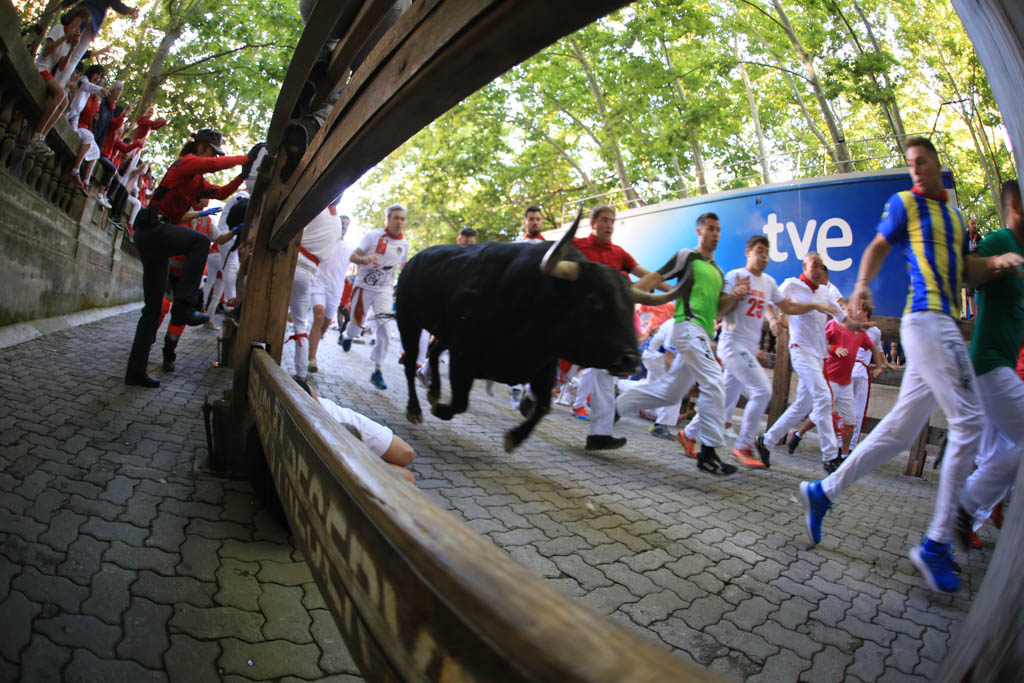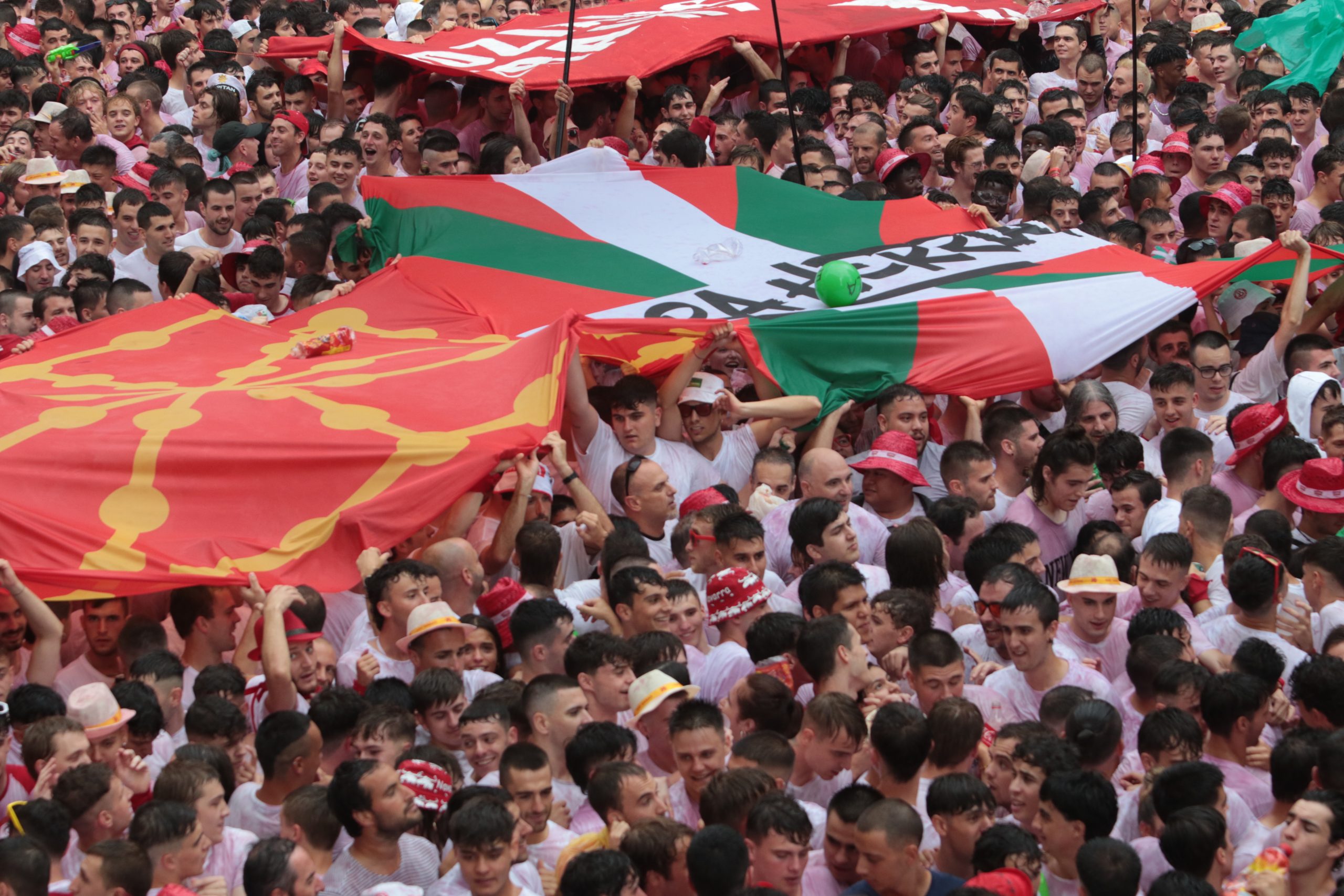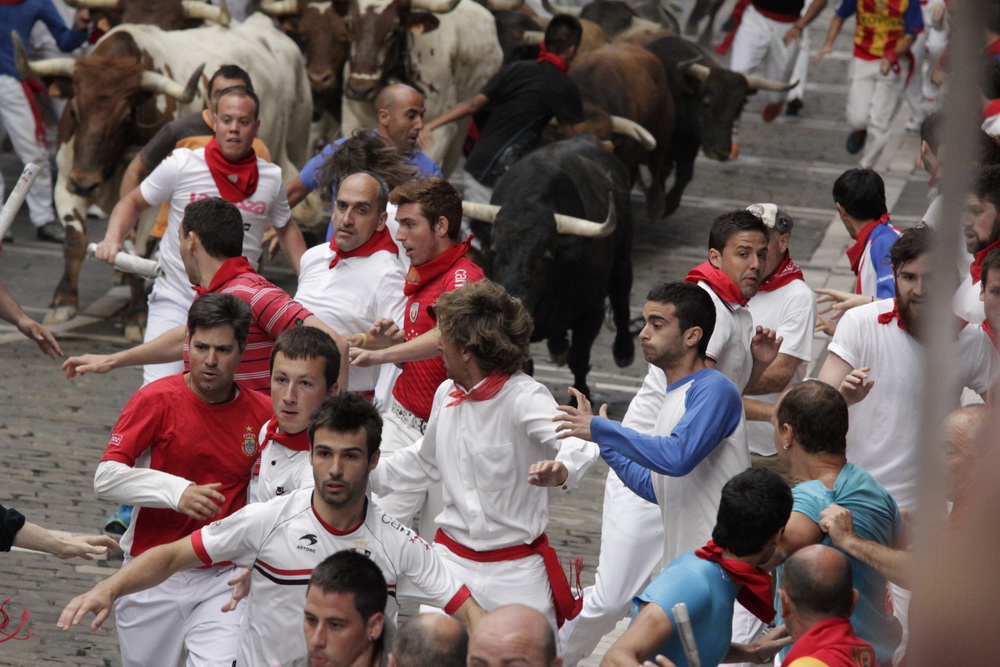With just a month to go to the start of fiesta in my beloved Pamplona, I’m happier than a badger at mating time. I thought the “Part One” done for last month was really just a piece of frivolous frivolity, but I’ve had some lovely comments so thank you very much. They are much appreciated, but as I always say, it only encourages me…
Category: Tim Pinks
San Fermin Things. An A-Z of Fiesta. Part One.
Read the Part Two HERE
To celebrate the fact that fiesta is rapidly coming down on us like a ton of bull, and also that the worst machine ever made since men lived in the caves of Altamira, (my computer) seems to be working okay after some ancient remedying, (if in doubt, give it a clout) I’m back with another article after 7 months.It’s just a piece of fluff and fun, really, but fun fiesta fluff to warm up my typing fingers, and this little A to Z of some of what makes up Pamplona’s extraordinary Fiesta of San Fermin actually contains, yes, the blindingly obvious but also some of those vital and varied things that makes it for 9 days and a thousand nights the greatest and most wonderful place on the planet. And yes, it is in many cases very much a personal list. 2nd part next month.
SUMMER CAMP FOR LUNATICS
San Thirteen Re-Seen
Well…that was some fiesta this year. A San Fermin quite unlike any I have ever known. This heartfelt city is famous for so much and renowned for so many things, but whatever it has become known for over the centuries, be it The Camino de Santiago, The Fiesta of San Fermin and all it entails, the peñas, the bull runs, Hemingway, Osasuna (just kidding…I think!) the clue is in the word “heartfelt” there.
(English) SLEEPERS, by Bill Hillman
Image: Miguel Goñi
Billseye
by Tim Pinks
The chap in the superb photo below, for those who don’t know him, is Bill Hillman, and he wrote something about one of this years runs that I thought was just so good it needed to be seen.
As those of you who read this more or less monthly series of articles knows, I almost always prefer to write about anything else but myself. But this month I’m going even further, as not only am I not going to blow my own trumpet, but I’m going to use this space to blow someone else’s. The remarkable piece below isn’t even written by me, but by the above mentioned Bill Hillman, one of the “new” generation of bull runners, and a very good one at that.
Although there is slightly more to the article than that, because he was actually running that morning as the dramatic events unfolded, and he gives what for me is a real skin-tingling account of what he experienced. I think it’s an excellent piece, and parts of it, as mentioned, for personal reasons which I wont go into here, left me shaking. As I say, Bill wrote the article, but I’ve furnished it with the pictures. Hope you don’t mind, Bill. Take it away, maestro.
SLEEPERS
By Bill Hillman
There’ve been many deadly human pile ups in the history of Pamplona ’s bull run. This year a pile up hospitalized 23 people and left one battling for his life.
On July 13th it was the Fuente Ymbro bulls’ turn to run the streets of Pamplona and I was happy because they were noble and majestic and I always ran well with them. I left early from my starting position at the last section of the course like usual and was striding cleanly in the center of the street with good vision of the herd as they approached. Three galloping black bulls lined up in a loose string with Aitor, the best young Spanish mozo running the lead animal. Aitor strode in his tall, long gate in front of the snout of the muscular animal?man and beast in perfect synch. Aitor’s white hoodie with black and red stripes fluttered as I matched their pace and approached, shoulder-to-shoulder with him.
As I cruised beside Aitor a woman tripped in front of him. He started to fall and I surged in and swung my paper behind his back and swatted the bull’s horns to attract him away from goring Aitor. Aitor dropped to the stones and I led the bull and ran in front of his horns. We merged into one speeding force before the tunnel into the arena.
As I stepped into the tunnel a small pile-up of five people tripped me. I tried to leap it and fell flat on my belly. The bull ambled on. I crawled to the two-foot tall opening that lines the bottom of the tunnel and slipped inside. The room is large and empty.
Suddenly screams volleyed in from the tunnel and a powerful roar of horror exploded into the dark room. Dozens of runners flew in through the low opening. I reached down and pulled them in. Suddenly Aitor’s striped sleeve appeared and I yanked him through and to his feet. The inflow of bodies stopped but the dread continued. I got down on my belly to look out. A regal white bull sat at the opening of the tunnel in quiet meditation. At the entrance to the ring a horrific mountain of people jams the path into the arena. Then the white bull climbed to his hooves. The runners in the tunnel scrambled.
I decided I should go out and try to help if I could. The white bull gets up and trots into the pile. I crawled back out into the tunnel and finally clearly saw the hundred or so white and red clad people crushed in the opening to the arena. Twelve gigantic bovine are stacked atop them in the center. The white bull turned and I panicked and nearly jumped out through the slot on the other side of the tunnel, but he didn’t attack. None of them did. They were afraid and the fear mysteriously calmed them instead of igniting them to rage.
Then something gives way and the blockage breaks. I helped Josecho nearly close the red metal doors and then followed him in. Regretfully I stepped over the fallen bodies. Then I was onto the sand of the ring. The bulls vanished. I went back to the unraveling pile and pulled people out until they all scrambled away. Underneath it I found a scattered pile of tennis shoes and five slumbering men. Their faces were swollen like big red tomatoes slowly turning blue. All of their mouths were agape but none of them seemed to be breathing. I looked up and the herd materialized and circled the arena dumbfounded.
Afraid that the bulls will return and finish off the unconscious men, I grabbed one of them by the arm and drug him away. It looks like someone bludgeoned his head with a baseball bat. Others appeared and we picked him up and tried to give him to a Policía Foral. The officer only yelled at us and waved his baton in our faces. We put the sleeper down on the white sand. I looked at him and knew he was very bad. His face was bluish-purple and he was clearly dying.
A mozo with a colorful shirt yelled and picked him up. I helped carry him and we cross the ring. A Red Cross medic appeared and I screamed “¿Dónde?” in his face and he pointed. We crossed the ring. There’s an erratic electricity that exudes from the dying; it ejected sparks out into my hands and numbed them as we crossed the ring. The life inside him undulated and surged under his skin warm in my hands. Suddenly I was exhausted and nearly fell as we approached another tunnel.
With the last of my strength we carried him through a door up a flight of stairs. A stretcher flung out of a doorway at the top and we put him down unconscious and purple with his mouth urging for air. As I turned to leave they carried two more in behind him?both asleep and looking very grave. A pale young man gored under his arm walked in?his shirt torn, wet and red. His eyes are wide and strangely placid.
More “Forales” appeared. They push all of us away including the gored young man. I yelled “¡Cornada!” and point at the goring. And I think he got in before the one in the colorful shirt put his arm around me and led me away. I tried to make sense of it all as I climbed out trembling and remembering the way his blood gushed and convulsed under his skin like the life was running scared to escape.
As I got outside I realized I had to find my wife and I ran down to our place and buzzed and they said she was looking for me at the arena. I ran down to Bar Txoko and they said she was just there and I rounded the corner and there she was. I took her in my arms and she throbbed and cried and we held each other in a doorway for a long time. Then she finally calmed and smacked me across the face for scaring her and we laughed, she still doesn’t understand why I do this. As my friends appeared safe and healthy I remembered why I run and we all hugged a lot at Bar Txoko.
Then someone told me they’d screwed up with the doors and I sat with my head in my hands and wondered if the young man was dead.
Later I found out his name was Jon Gerónimo Mendoza, a 19 year old from Vitoria Spain . He’d fallen in the pile up and the many people and the immense, six ton herd crushed his chest and suffocated him. He was in a coma and on life support at the local hospital, most people gave him a slim chance of survival.
As I watched the footage of the run I realized that it was partially caused by a man in charge of one of the doors into the ring. He’d opened it to let some of the “Forales” in so they could line the ring walls and batter anyone who misbehaved. There was a huge swell of valientes (runners who run before the bulls arrive) as the door opened the valientes pried the gate ajar and that set the stage for the terrible. I remembered trying to hand the “Forales” John Jeronimo’s limp body and him waving his baton in my face. I recalled wanting to punch him square in the jaw and I wished I had. Then I saw a video of another Policía Foral carrying one of the sleepers by himself and stopped blaming them.
But there was more to it all than some mistake at the gateway. The pile already started in the tunnel when the door opened. The Valientes caused it. These uninformed first time runners often cause folly on the course. Many of them are American tourists who’ve done no research or people who are half drunk with no sleep, no knowledge, going on rumor and stupidity.
For the past six years I’ve given two bull-run tours a day for first-time runners, teaching them the basics, warning them on the dangers and giving them practical advice on how to react and plan their run. I can’t help but wonder if enforcing some sort of mandatory certification for first time runners could have at once reduced the number of people on the street that morning and avoided the chaotic pile up all together. I wish I’d had a chance to say something to Pamplona about it. Some way to voice my idea and offer to help.
After over 24 hours on life support Jon Gerónimo miraculously woke up from his coma and began to speak. The bull-run I love dodged a major catastrophe but if nothing changes I fear for the future of Pamplona ’s legendary run.
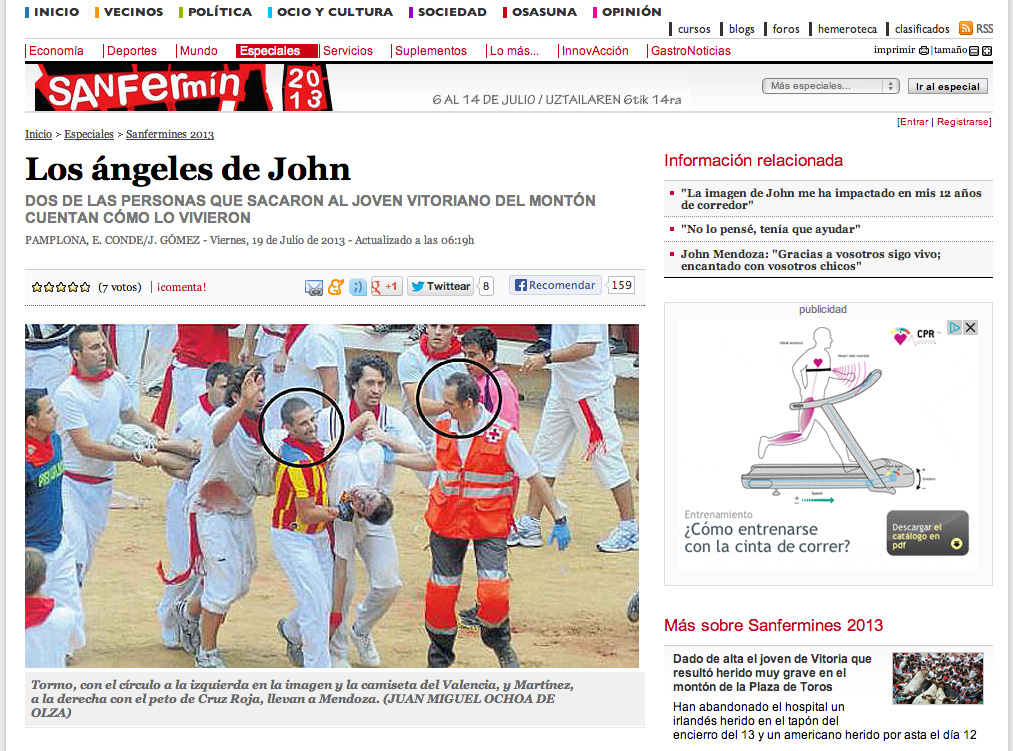
Tim Pinks again…
Wow, Bill. No matter how many times I read it, I still shake at the same parts. Enhorabuena, my friend.
The photo above, by the way, shows Bill amongst other runners carrying the seriously injured (yes, actually, dying) Jon Gerónimo Mendoza Ruiz to the bullring infirmary. He’s the one between the two people circled. The article is about how Jon’s father has called his rescuers “angels.” Well, if that was your son, brother or friend, you would, wouldn’t you? Jon Mendoza, by the way, is making what the doctors have called an amazing recovery, and is doing okay, although there will be a couple of months before he completely recovers, I understand.
Oh, and “angels?” I understand completely Jon’s Dad calling them that, but I don’t think Bill for one moment would describe himself thus, but I do know one thing…if I was in trouble, he is exactly the sort of human being I’d want covering my back. He’s one of the good guys.
For those of you who don’t know, Bill Hillman is from Chicago and has been coming to San Fermin since 2005, although he had to miss 2007. He has ran the bulls in Pamplona 59 times and so has only missed a very few runs. If you include runs he has done in Sanse (San Sebastian de los Reyes) and Cuellar then it brings it up to 63 runs.
His debut fictional novel, “The Old Neighborhood” is out next April, to be published by Curbside Splendor, and he happily admits his writing has been influenced by Hemingway. Well, that’s not a bad start start, is it?
Thanks again Bill for the article, it is, in parts, a truly emotional and haunting read. Describing those badly injured people as “sleepers” is something that will stay with me forever.
To end, a video of that day. But as many of us have seen the television and bullring filming of what happened that morning, here’s coverage from a mobile phone taken that morning. Scary stuff.
Ya falta mucho, everyone…but ya falta menos.
Tim Pinks
San Fermin and the Lion King
by Tim Pinks
(This was written just before fiesta)
Meanwhile…
Well… we’re nearly there, aren’t we? For those of us lucky enough and if we actually make it, the long wait is over, July is upon us and the next and last step on the Escalera will find us submerged deep in fiesta. It’s the exact opposite of the “Pobre-De-Mi.” It’s the “Oh-Lucky-Us.” This months San Ferscribblings start, as its the 25th anniversary, with something about one of the classic runs of recent decades, ends with the usual video clip I like to put in, and includes, for those that remember from a wee while back, the thing about a lion on the streets of Pamplona. Oh yes, only in Pamplona …
PAMPLONA IS A GIFT
Part One.
That great Sanferminero, Bomber, who so prematurely passed away long before his time this February, used to say, “Pamplona is a gift.” Thank you Bomber, because that so sweetly and simply sums up some of what this beautiful town and its inhabitants and fiesta mean to me. I used the same title but in Spanish for an article that was published in the Diario de Navarra newspaper on the 4th of April – Pamplona Es Un Regalo – because I thought it was such a perfect line. Especially as April has the fourth step on the ladder to fiesta and we were getting that much closer. The gift was slowly unwrapping…
KEITH “BOMBER” BAUMCHEN
One of the great Sanfermineros passed away on Sunday 24th February, and although so much has already been written about this extraordinary and enigmatic man by his family and friends, and the news has gone around the world of course, I wanted to collect some of what I’ve seen and put it all together.
This piece isn’t just for those who knew and loved him, and his hundreds and hundreds of friends around the planet, but it’s also for those who read this site but didn’t know him, but might like to know a little about a man who didn’t just take Pamplona to his heart, but also had people from that great town take him to their hearts.
My thanks to everyone who has willingly and gladly, or unwittingly and unknowingly contributed to this montage of memories. I shall give credit where I can, but I hope most people who see their photos or words used will understand that they all, every one of them, have added something rather wonderful to this celebration of a unique man. Take it away, Bomber…
A RUNNER WRAPPED IN RAY BANS INSIDE AN ENIGMA
Bomber. February 6th 1948 – February 24th 2013. `When the legend becomes fact, print the legend´, Thanks to Rex Freriks for this version of a Jerry Roach photo, and for the great quote from the film `Who Shot Liberty Valance.´I cannot claim to be one of those who knew Bomber well, to my great misfortune, but over the last few years I did get to know him a little, to my great privilege and pleasure. He lived an extraordinary life, travelling the world with the love of his life, Goldie.
Some of the people I shall be mentioning I know, and some I don’t. Here is just a very brief resume of his life, from someone I don’t know. It’s from one of his brothers, Roger, and was sent just after Bomber passed away.
Bomber and his beloved Goldie.“Keith Baumchen was “The Bomber” or as he was known in Pamplona , “El Bomber”. He was dynamic, powerful and full of energy. He was born in the middle of Iowa on a large farm, the 2nd of four children. He grew up, however, in Southern California during the 50’s and 60’s. His childhood hero was Zorro. He was good in sports and played varsity basketball and baseball at Monte Vista High School . He was the fastest pitcher in the league. When Keith was young he was a very good artist, mostly oils with a brush or palette knife. He won awards and sold many of his paintings.
Bomber made Garmisch Germany his home base in the summer of 1976, a magical Bavarian town nestled in the Alps . He decided to become a world traveler and document his journeys with photographs. The following summer he met the beautiful Karen Anderson and nicknamed her “Goldie”. They became an incredible team with Goldie planning the trips and Bomber making it happen. They would do 5 to 10 month trips to every part of the globe during a span of 31 years. Each year they also went to Pamplona for the running of the bulls in July as well.
Goldie passed away summer of 2008 and Bomber has been on his own since. He was visiting friends in Coral Gables , Florida when he went down with cancer. It was Bomber’s wish to come back to his family in California . He died with hospice keeping him totally comfortable at the age of 65. Like a shooting star, “The Bomber” was a legend and an inspiration for anyone brave enough to take life to the limit.
My brother Bruce and sister Sue thank you for the kind words and unbelievable support. The response to the “El Bomber” facebook page has been incredible. It is impressive, to say the least, that over 500 people have commented on the message we sent out yesterday. We plan to keep it going and also would like to do a memorial in mid June, maybe Lake Tahoe …..what do you think?
Bomber’s brother, Roger
There is of course so much more to a man like Bomber’s life than just a few paragraphs…but this is not about his life, but a celebration of it. Roger mentions Garmisch, where Bomber made his home with Goldie…well, this was Garmisch one evening this week…
Garmisch, Germany, Monday March 4th, in celebration of Bomber.Drew James Benson said of him, about how he left town for the last time towards the end of October:
“He slipped out of town quietly a day or two later, without a going away party or a fanfare. Like the true traveller he was, he slipped out of our lives the same way, quietly, quickly; off to the next adventure. I can’t believe he won’t return to Garmisch again this spring.”
Yoav Spicehandler said, perfectly and succinctly: “If a man be judged by the friends he had, then Keith “Bomber” Baumchen was a giant Sequoia. Tan bueno que era.”
Mozos juntos.On Sunday March 3rd Pamplona celebrated the third step on the stairway to fiesta. There was a service and mass held in the Church of San Lorenzo , where the figure of San Fermin is kept. Towards the end, there was a touching eulogy written by Chapu Apaolaza, and read out by Teo Lazaro Armendaiz.
I’m including part of the video here because just listen to what happens when Teo finishes speaking, around the 4 minute 7 second mark. Then, wonderfully, at about 4m 50, they sing a jota to Bomber and all runners. Marvellous stuff.
No words needed.
When news of Bomber’s death reached Navarra, one of the headlines in the local Diario de Navarra newspaper was “Goodbye to elegance in the bull run.” Bomber was pretty much the coolest guy many of us have ever come across, but when he dressed in honour of those folks “back home” in America who’d put on their Sunday best for church when he was a lad, and he put on his Sunday jacket to run with the bulls, well, I bet even the bulls felt the chill.
Elegant from tip to toe, in full respect of not just the bulls but for the town and the fiesta itself, Bomber was a true Sanferminero, accepted by the people as one of them.
Band on the Run. Bomber, Joe Distler, Jim Hollander and Jesse Graham. Photo by Bernard Tyers.There are so many stories, and so many photos, that it would be easy to go on, but, as George Harrison sang, all things must pass, so I’m coming towards the end now. If everyone could have just a little of what Bomber had, this beautiful planet we live on would be a better place.
I’m pretty sure that almost everyone who ever met him will not have forgotten him, no matter how briefly their paths crossed, and when they left him the world would have seemed a nicer place, there would have been a spring in their step, and their mood would have been better and if there wasn’t a smile on their face before they met him, I’ll bet there certainly was afterwards.
Bomber and Chloe, in a photo he sent her after San Fermin last yearHere’s what Chloe Drakari-Phillips said about this gentle soul: “Bomber encouraged me to take chances and whatever decisions I made to believe in them and never look back with regret. The advice he gave was second to none. He was kind, loving, artistic, modest, honest and had the biggest heart.”
Yup, I think everyone who knew him would agree with that. As I said above, I am so fortunate to have got to know him a little bit in Pamplona these last few years, and I will always take to heart his warm words of praise, and encouragement, about my attempts at writing these last couple of years. Said, of course, in his own inimitable way.
For my part, I’d just like to quote here something I put somewhere else about Bomber. It’s from “Last Night in Twisted River” by John Irving:
“We don’t always have a choice how we get to know one another. Sometimes, people fall into our lives cleanly – as if out of the sky, or as if there were a direct flight from Heaven to Earth – the same way we lose people, who once seemed they would always be a part of our lives.”
Sweet Runnings, Bomber. I knew you because of a place that is heaven on earth…Pamplona…and though you may be gone from this earth, you’ll always be a part of so many lives. I have no doubt that while you may be Resting In Peace now, with your beloved Goldie, you’ll also, both of you, be Running In Paradise. It was, and always will be, my pleasure knowing you.
A unique, enigmatic and in the true sense of the word, a beautiful man.
Rick, Joe, Bomber and JacoboJacobo Roura Formoso, on the right in the photo above, wrote: “Goodnight Bomber, never forget your freedom, Pamplona will always be yours. A hug, my brother.”
And Rick Musica, on the left above, amongst other things, wrote this last week:
“As sad as today has been, we must not be selfish and mourn OUR loss. Our loss was truly sad, no doubt about it. But, today, Bomber regained what was, truly, his most immeasurable loss, his Goldie. I am SO honored to have been a part of THEIR time here, and in the most magical place EVER!
As we gather this week (it was for the reunion in Florida) to celebrate our love of all things Fiesta, let’s take a minute to remember why we love it so much!
For all those who won’t be with us this week, you will NEVER be without us….
Tears, but mostly smiles, remembering the great times and people who make this what it is…
Viva San Fermin, Gora San Fermin, y Ya Falta Menos……”
As is the case so often…well said, Rick.
Cool runnings…Julen Madina Ayerbe, front right, Miguel Angel Eguíluz Lopez, front left, and Bomber and bull. One of The great shots.
When Jacobo wrote “Goodnight Bomber,” it is, all too sadly, true. But it’s only “goodnight,” that’s all. Bomber sleeps now, but his soul is with Goldie and they will be running together. And their spirits will be soaring like birds in flight, with only that sense of freedom and life that the bull run can give you.
For Bomber, finally, there are no limits, because for him, he’s made it. Ya falta nada…Viva! Gora!
For Bomber
A lovely video was put together by Jack Denault last week, which is just fantastic. The music and words to the song were just perfect, but he has allowed me to use not just his compilation, but to change the music too. Thanks Jack. You see, I wanted to, if you’ll excuse the pun, have some music with a bit of…San Fermeaning to it. Sorry…
He would probably be a little bit embarrassed by all of this, but for one more time, Bomber…take it to the limit!
Tim Pinks
A MIXED PINTXO-PLATTER OF MUSINGS
A pre article note: As I was writing this month’s piece and putting it together to go to sanfermin.com’s pages, two things happened that have to be mentioned, and that I shall come back to very soon. The first thing was the incredibly sad, and extremely untimely, passing away of the great Bomber, one of the most wonderful foreigners to grace the streets of Pamplona for the last 45 years. His friends know of course, that goes without saying, but as he was a real, true, and bonafide “sanferminero” as the locals say, I thought those who didn’t know him should be able to read about a man that loved the town and all it stood for…and was loved right back by the town and many of it’s inhabitants. So there will be an extra article prontissimo, dedicated to Bomber, because if anyone deserves it, he does.
The other thing to crop up came totally out of the blue and was something I first read just a few days ago thanks to the people at Kukuxumusu who put this website together. I shall write more about it again, but at the end of this month’s literal bull-runnings, under the subtitle “The Bull” you can read the beginning of what I hope will be an ongoing narrative up to, and including, this year’s fiesta. Okay, I’m leaving this month’s writings as it was originally written, so let’s get the virtual corral gates open…
A MIXED PINTXO-PLATTER OF MUSINGS
Yup, for this month I’m offering up another mixed mish-mash of mutterings, indeed a veritable pintxo-platter of Pamplona ponderings. These articles never really get planned, you know, (as you may have noticed from that beginning), I just start writing something down at the top of the page and end up somewhere that’s as much a surprise to me as it may be to you. Usually the bottom of the page… But after last months Clock and Bull Story, which more or less had three courses, almost like a dinner with a starter, a main and a dessert, I thought I’d just dip in and out of various fiesta related things, rather as one might go on a Pamplona pintxo perambulation around the pubs of the old part, or a tapa and tipple trip amongst the taverns of the old town, and see if I couldn’t serve up a smorgasbord of San Fermin related scribbles. Okay, okay, enough of this edible orgy of alliteration. Apologies!
Once upon a time, way back then, when all photos were in black and white and the only colour ones were sepia coloured, (to me the photographic equivalent of those beautiful stained glass windows one finds in a church), a man got his photo taken. Nope, it’s not a very good quality photo, but in it’s ageing and weathered state it transports us back to a very different time in Pamplona ‘s fiesta history. My thanks, as so often, go this month to the Navarran newspapers for my piratical plagiarising plunderings.
Pamplona’s Favourite Uncle
Javier Echeverria, on the right.In Diario de Noticias “Especial SF 11” supplement of Tuesday 5th July that year, they had a piece about one of those characters that would have no doubt passed us by if the journalist Fernando Huarte hadn’t written about him. He has long since passed away, as he died in 1911, but he played an important part in the fiestas of this town without equal, and he played that part for over 70 years. So yes, we’re going a long way back now…
His name was Javier Echeverria, known to all as Tio Javier, or in English, Uncle Xavier. We don’t have an equivalent English name, as it comes directly from the Basque of its origins, from the meaning of “new house.” But this man provided a direct link between the Comparsa of today, and that of yesteryear. The Comparsa, by the way, are that wonderful troupe of giants, big-headed people and those half-man half-horse creatures that twirl and dance, whack and thwack, and run and have fun around Pamplona during fiesta.
Tio Javier was a gypsy, and no one really knows where he was born, but it was inside Navarra somewhere. They do know just about when though…1811. I told you we were going back a long way. Some time in the 1830’s he appeared in the “old” Comparsa, before the original figures, which had become run down, were replaced in 1860 by the ones still dancing and bringing joy today, hence his being a link , even over a hundred years ago, to what was even then “yesteryear” – a different time and a different century.
Part of the troupe that is the Comparsa, showing the giants, with the African King and Queen in the second row.He was a “chunchero” or a “chunchunero”, a pipe and drum player, and although the official town hall records only really note the relationships of the musicians to the Comparsa since 1848, there are enough earlier documents that name Javier Echeverria from the early 1830’s as already a municipal chunchero. He was always there, never missing a day, and so it appears that he and the Giants were inseparable.
He was an excellent player by all accounts, and there is even a surviving cutting from the now defunct newspaper The Echo of Navarra, and although there is no exact date on it, it is from July 1900 by a travelling chronicler who goes under the name Un Forastero, (A Stranger, An Outsider), while describing the giants and entourage in the street:
“And there also was that honourable gypsy from Orcoyen, Javier, the same fellow from the last forty years, with the same copper colouring, the same waistcoat, the same chulubit and I believe the same patch on the drum. But the best, the surprise, was when he invited the people to dance the jota along with him, scratching from his own repertoire along with the sound of another chunchunero. Horns of the Devil! What a to- do, what whirling of feet and moving of arms! You should have seen it boss, the figures dancing at his side looked like a picador flying around the arena. And he noticed it, too: they’re going for it! And within seconds everyone was dancing with the giants.”
Another photo of a favourite uncle, and his drum, now in the Municipal Archive of Pamplona The drumWhether it was because he was a gypsy and felt a certain affinity with them, who knows, but he always played with the two giants that were the African King and Queen. He just seemed to adopt them.
But time waits for no man (although it waited a long time for him), and there came a point when he couldn’t play any more. In 1908, when he had being playing with the Comparsa for over 70 years, time finally, slowly, caught up with him, and due to an illness he had to retire. Bare in mind though he was in his late nineties by then! That year the town hall, under one Don Daniel Irujo, made a heartfelt tribute to Javier Echeverria, which he received having walked from his village of Linzoian, up in the hills near Burguete, about 25km away. Remember, again, he was in his late nineties, and remember also…it’s a mountainous, bendy route, (I hesitate even to say it was a “road” back then) which took him four days. And then he had to get back again…I tell you, there’s gotta be something in that pacharan…
I’m not sure what happened in 1909, but it seems he at the very least was in town for fiesta, but amazingly, in 1910, he was definitely back. He must have loved those Giants, because at the age of 99 he again walked from his village in north-east Navarra to Pamplona , and again it took him 4 days, proving that nothing would keep him from his cherished Comparsa.
The troupe that makes up the Comparsa, as drawn by Mikel Urmeneta.But for the first time in his life, at nearly 100 years of age, he found that his hands couldn’t follow the signals from his head…and he couldn’t play. But, even though this was so, it didn’t stop him from being with his friends, both real and make believe. He still brought his pipe and drum with him, and one more time accompanied that magical troupe of figures, walking poignantly and silently alongside them, the zaldikos and kilikis, and the cabuzedos and los gigantes, including, of course, his beloved African King and Queen. It was to be the last time.
At the end of the fiesta the local press, in collaboration with the fair and the cinema people, amongst others, donated a part of their profits to him so that this gypsy, the town’s Uncle Javier, could have a better quality of what remained of his life.
When the fiestas of 1911 began he was in the Hospital Provincial. Where some people might die, as they say, “in full regalia”, well, Javier Echeverria died in full fiesta, on the 11th of July 1911. A local chronicler wrote, and please excuse my translation: “It has been the first year that Echeverria has not been able to be a part of our joy in fiesta, and it’s as if it couldn’t support the weight of his absence, as if the rockets and the music felt in the near distance the pain from his bed, and so fiesta transported his spirit, and Echeverria died at one with the fiesta.”
La Plaza del Castillo
The Plaza del Castillo, as it once was.Progress happens. It has to. But when it comes to having to reform or renovate old, classic town centres, there is a way of doing it to try and minimise the damage, and to perhaps try and make sure that in an area of ageing beauty, any renovation blends in as much as possible to the existing style.
Only a bloody idiot would think that the “new” Castle Square in Pamplona is an improvement on what there was before. I am not going to get into the politics of the reasons for what was done, or the rights and wrongs of it…even I can understand that if work needed to be done to build a multi-level car park underneath, then something had to happen.
But to take what was a beautiful old square and do what they did to it is a disgrace. Yes, I know they needed to build some above ground constructions at the corners so they could house an entrance to the lifts and stairs to get below, (plus access to disabled toilets – a good thing), but why-oh-why did they have to make them look so glassy and modern, as opposed to building something in material that would match the buildings and feel of the square?
And why couldn’t they have put the railings that surrounded the plaza back, to at least give a bit of definition to the square, if not just to provide a convenient place for people to stop and ponder, to rest and lean against, or to sit on and dangle legs from? As I say, even a bloody idiot…after all, it’s not rocket engineering…ah well. I still live in hope that they’ll put railings back in the square to finish the job.
Officially sanctioned destruction and vandalism of the beautiful square, 2001. From Diario de Navarra, Nagore/Calleja Merche Galindo. Diario de Noticias.Twelve years ago, on Monday July 24th, 2001, the vehicles and chainsaws snuck into the plaza at 05.10 a.m in the morning, and began to hack down the trees from three sides of the square. Only those trees on the Bar Txoko to Hotel La Perla side were spared. They came in at that ungodly hour, unannounced, to avoid the confrontations with the locals that they knew would surely happen. There was a riot that day, of course, and I was there with Dutch Shortie when it went off, and one day I’ll write about that too, but this isn’t the place to do it yet.
The next year the plaza was a building site, but by 2003, yup, 10 years ago, the square was finished and ready for fiesta. They had replaced the destroyed trees with new ones, the grass had been replaced and flowers planted…but something was lost. The “square” and the symmetry of it had gone, and I swear some of its spirit had gone too. Yes, buildings and places, if they are loved, have a soul to them, and it’s given to them by us.
It wasn’t the first time the square had been worked on, obviously, as over centuries things change and buildings are knocked down, or modernised…or just built on top of! The last major change to the square before 2001 was in 1931 proving, (at least to me) that even back then they were making a hash of so called “progress.”
The square in 1905.I think this is a cracking photo. It’s taken from what appears to be above the Café Iruña, perhaps from one of the balconies, and so is a view facing south. At the top left is where the present day Bar Txoko is, then there is the gap where the street Espoz y Mina is, and then we cross to the building that to many of us foreigners will always be called Banco Central, whatever bank is currently occupying it. But look at the middle of the building, and the huge arched central façade, followed by the rest of the building. That glorious central part was the theatre, the Teatro Principal, and with that whole building intact the plaza was perfect, the classic square practically closed on all four sides by beautiful buildings with shaded arcades to walk under.
In the middle of the picture you can see the top of the old drinking fountain, surrounded by a circle of trees. That figure popping up above the tree level is a statue of Mari-Blanca, made by Juan de Perat in 1788 especially for the water fountain that was to be constructed in the square and installed in 1792, during the time that enabled the town authorities to provide various drinking water fountains to the population in that era.
And at the front of the shot is the old wooden bandstand, what they call the kiosk, which between 1900 and 1910 was placed right in front of Cafe Iruña. And that was then…
And this is now…the chupinazo in the plaza, July 6th, 2012.Today, over a hundred years later, this is what we have. Yes, it’s still a lovely old square of course, and I still get that old thrill whenever I approach it, from whatever entrance, but I will always wish they’d bring the railings back, and I’ll always hope they’ll knock down the modern public entrances to the underground car park and construct something more I keeping with the architecture of the square.
But, back to the past for a little bit longer. In 1910 the wooden kiosk was moved from in front of Café Iruña to the middle of the square, and the old statue of Mari-Blanca was moved to the Plaza de San Fransisco until 1927, when it was moved to it’s present home in Taconera Park, (near the Hotel Tres Reyes) where it resides in peace amongst the gardens.
The central part of the building that contained the theatre was demolished, so opening up the Avenue Carlos 3rd right into the square. The façade was kept though and reconstructed brick by brick for the main entrance of the new theatre around the corner, now the Teatro Gayarre
The old wooden kiosk was replaced by the present stone one in 1943, and it has drinking fountains incorporated into it. Before they constructed the monstrosity of a stage they use now for the nightly concerts during fiesta, that small stone bandstand was where the bands played in the square from midnight to about 3 a.m, and everyone danced in front of it and around it, and in those days my (yes, my!) beautiful square really was the centre of fiesta.
A French painting from 1829, with the title “Combat de Taureaux a Pampelune (Espagne). Showing a bullfight in Pamplona ‘s Plaza del Castillo.Indeed, if proof were ever needed that the square was always the centre of fiesta, well, that painting above doesn’t lie, as once upon a time, before Pamplona had a bullring, the bulls were run through the streets and into the plaza, where, in common with many other Spanish towns and cities, they were then fought in the central square. But that is most definitely a tale for another day!
The crowd I was with in the first couple of years slept in the square, partied in the square, ate in the square and danced in the square. Post bull run we met up back there. That amazing square really was the pumping, pulsating heart of our first extraordinary years. And, despite what they’ve done to you, my wonderful Plaza del Castillo, you still are.
“The Bulls” – Miura!
The mythical Miura bulls, Pamplona encierro legends, at home in Andalucia. ©Patxi Arrizabalaga. 2010. Torosysanfermines.blogspot.comThe name Miura is famous, and infamous, and central to the history of bullfighting, not just amongst bull runners of course, but in the taurine world as a whole. I have to be careful here, as there are many people out there whose knowledge about the bulls and their world goes way beyond anything I’ll ever know, but I wanted to finish this month’s piece with just a little bit about the bulls, and especially the Miuras and their connection with Navarra.
Although the Miuras (both the bulls and the family!) are from Andalusia , and live on the famous Zahariche ranch, they have a direct and fitting connection to Navarra. If you go to the official Miura website, one of the first things you’ll come across is on the very first page, under “Origins and History” where the direct literal associations between the word “miura” and its Basque and Navarran variants are obvious.
A mighty Miura, “Ermitaño” 12th July 2009. © José Antonio Pérez. 12 de julio de 2009.
Amongst the Euskera (Basque) words, and the variations thereof pertaining to the origins of the word “miura” and the bulls, you’ll find the words “mihura, miura, migura and mura”, along with documentation linking them to Urdax (1726), Pamplona, (1773) and Zugarramurdi (1635 and 1659). And my favourite bit is that it’s believed that the word “mihura” is from the Basque word for, in Spanish, “muerdago.” Which in English means “mistletoe” which for some reason I really rather like.
The Miura bulls come from various stock then, including as mentioned Navarra. Way back in 1879 the bullfighter Rafael “El Lagartijo” Molina Sanchez fought a Navarran bull called “Murcielago” in Cordoba . This bull survived 24 jabs and stabs from the picador and fought with such passion and spirit that this brave animal was saved, and so became what in the bullfight world is called an “indulto” – a pardoned bull.
Ermitaño again. If you were in any doubt…bull running can be bloody, dangerous and deadly. ©José Antonio PérezEl Lagartijo, who was a friend of the Miura family, gave this animal as a present to his friend Antonio Miura, and the family sired him into the line of their own bulls, and the rest, as they say, is history. It’s said, according to last year’s “Sanfermines 204 horas de fiesta” magazine, that “thanks to this animal, some Miura bulls can still be seen to share certain characteristics with Navarrese bulls: bright red hides, short, upright horns, and red “birds eye” markings.”
And now, from the bulls, those beautiful and noble animals, to something I had absolutely no idea I’d be writing about until a couple of days ago.
“The Bull.”
Sergeant Gareth Thursby friends.On September 15th last year, at a place called Checkpoint Tora in the Afghan province of Helmand , a young man died, a long, long way from home. This July, a little bit closer to home, but still in a foreign land in a place called Pamplona , in the Spanish province of Navarra , he will be remembered, and honoured, and commemorated by some of his colleagues.
He was Sergeant Gareth Thursby, of the 3rd Battalion The Yorkshire Regiment, and he died aged 29… just 6 days short of his 30th birthday. Another even younger man died that day in the same incident, Private Thomas Wroe. I say even younger, because he was still a teenager at 18. Just a lad, really.
But it is to the friends and colleagues of Sgt. Gareth Thursby that I return, because thanks to this website and the boys of Kukuxumusu and a news item they posted last week, I learnt all about this. What does this have to do with Pamplona , San Fermin and the running of the bulls?
Well, as the link explained, his friends and colleagues have decided to honour him by running with the bulls, purely, it seems, because of the fact that his nickname was “The Bull.”
sanfermin.com 27/02/2013. 9 English soldiers will come to the Sanfermin Running of the Bulls to gather funds for the families of fallen comrades
sanfermin.com 27/02/2013. 9 English soldiers will come to the Sanfermin Running of the Bulls to gather funds for the families of fallen comradesOn the 15th of September, 2012 a sergeant by the name of Gareth Thursby died in action in Afghanistan. To some of his friends and comrades he was fondly known as the “The Bull” and now these same friends want to come to take part in The Running of the Bulls during the Sanfermin fiestas of 2013 in order to pay homage to their dead comrade and to gather funds for families of other dead comrades
This year we will see some special participants in the Sanfermin Running of the Bulls. Nine soldiers from the British army who belong to the Third Battalion of the Yorkshire Regiment will take part in the running of the bulls in memory of their fallen comrade, Gareth Thursby, who was killed in Afghanistan. Sergeant Thursby lost his life on the 15th of September, 2012 and he leaves a wife and two children. Thanks to the social networks, we have learnt from one of his colleagues, CorporalMathew Pritchard, about the initiative which he and some other soldiers have taken to start a campaign to collect funds in memory of the fallen soldier for the ABF The Soldiers Charity. This organization exists to help the families of soldiers who have died in action. They aim to collect a total of 23.000 euros and they have already reached the figure of 6000 euros through the web page: justgiving.com/3YorksBullRun
Sergeant Gareth Thursby was fondly known to his comrades as “The Bull” and it was thanks to this nickname that the idea arose to take part in the running of the bulls in Pamplona and to collect funds for the families of fallen soldiers at the same time. For the moment, some nine soldiers have agreed to come and they are already in training for the event. They hope to come to Pamplona on the 5th of July and to take part in the first Sanfermin running of the bulls on the 7th of July at 8.00 a.m. They have formed a group in Facebook (3yorksbullrun) and an account in twitter (@3yorksbullrun) where they are continually updating their plans for this commendable project.
At his funeral they provided a wreath in the shape of a bulls head, and when they run this July they shall be wearing t-shirts with their friend’s face on it. And also, and best of all from my point of view, they are also doing this to raise money for the Army Benevolent Fund, and are hoping to raise 23,000 euros.
I said at the beginning of this article that when I write these things I never know quite where they are going to end up, and never is this truer than in this case. I shall try and keep you informed and updated on their progress as we get closer and closer to fiesta, but until then I shall leave you with these quotes about him.
The Bull Run Team out on patrol. A long way from home…The Bull Run Team out on patrol. A long way from home…
The first is from his wife. He was married to Louise, and had two children, Joshua and Ruby: “Gareth was the love of my life. He was an amazing husband and father, full of life and kind hearted, with a passion for his work and his family. He was brave, hardworking, a loving husband who was a devoted father to his children. Our hero.”
And amongst what his commanding officer, Lieutenant Colonel Zachary Stenning, MBE, said, was this: “We have lost one of our finest, Sergeant Gareth Thursby. His nickname “Bull” epitomised everything: he was strong, confident and incredibly robust. He was admired and deeply respected by his soldiers and peers for his soldiering skills, physical strength and forthright honesty. Utterly professional, his standards were legendary.”
And it is to the legendary and world famous town of Pamplona that his friends will come to honour him. Pamplona, this town that so many of us love so much, will no doubt do him, and them, proud.
Ya falta menos…
As I finish this updated piece it is March the 3rd, one of the Escalera Days, and in the month since the last one on February the 2nd, a month during which as mentioned above Pamplona has lost one of it’s amazing foreign friends, the irreplaceable Bomber, (again, more of whom very soon), we have heard about someone else who never even knew the place, but who will be here in spirit this July, thanks to his friends. With that, for the moment, I think there is nothing more to say.
There will be no video this month, it doesn’t seem appropriate, but, as always, and more poignantly than ever…ya falta menos…
VIVA SAN THIRTEEN!
Some books to snuggle up with during Winterlude
View from the bandstand in the Plaza del Castillo.
Well, it’s all over now, but as this article was originally written for the Christmas period, (but los locos de Kuku couldn’t squeeze it in), I’ve decided to keep the Christmas and snow theme whilst changing a couple of things here and there. But just because Christmas is over it doesn’t mean it’s spirit has to be…and let’s face it for us guiris, with the arrival of January 1st we are given one of the best presents you can have – the “Escalera” and the countdown this year to, yup, San Thirteen! And we get the same present on the same date every year…and it’s always brilliant.
So, although it’s done and dusted for another year, Christmas is such a colourful time, with all the decorations put up at home and around the town and of course the Christmas trees and the bright lights shining their festive fluorescence over us. And when it’s snowing and everything is covered in white, a town develops its own special kind of magical beauty, and Pamplona is no different. For those of us that love the place during fiesta time it has its own unique, crazy and yes, surreal nature. But if you fast forward five months or so, that magic is still there, and it’s still fiesta time, all be it with a Yuletide jingle tinge. And when it snows, well, like most cities when it snows the beauty is all the more ethereal and yes, spiritual.
Sometimes, black and white looks beautiful.And if you’ve ever seen the city at night, blanketed and tucked up in snow, with the Christmas window displays in the shops lighting up the streets with that warm glowing haze that only seems to happen during the festive season, while the plazas and streets shimmer from the illuminations hanging overhead…well, you’ll know just how pretty it can be. Add to that the fact that the Spanish don’t give their presents out until January 6th and you can understand why for some of us who have been there at Christmas time find it is hard to end the festive season on New Years Day. Me included, as I’ve just this week sent out a couple of things for the Spanish present giving day.
I’ve been in Pamplona many a time in winter, and if you can imagine how beautiful the town looks under snow, just imagine what the rest of Navarra looks like. Wow.
The Snow Hall.So as we’ve just had Christmas and it’s been a time of gifts I thought I’d run through a few books that could make a great present for someone, especially if they’re Sanfermineros, but also if they love Spain or indeed just love books. Many of us know some of the fiesta and Pamplona or Navarra related books, so I’m going to lump a few of my favourites together here. Some are on Amazon, some are not, so I’m going to start with a couple of my favourite Pamplona bookshops where these books are available. It’s only fair too that I can only comment on books that I have read, so if there is anything new out there that is Pamplona themed (and there is!) I’m sorry but I can’t write about it until I’ve read it.
But as we countdown the months before fiesta engulfs us again, and you fancy feeding your addiction with some reading matter, here are just a few ideas.
La Casa del Libro
The famous (well, ‘tis to me!) bookshop owned by Carmelo Butini Etxarte.I have two favourite shops in the old town, and the one above is probably the establishment I visit most in all Pamplona, (at least amongst those that don’t serve alcohol) if only to get my daily paper. The other one is also a bookshop, a real little goldmine of literary treasure, and I’ll come to it in a minute.
There are so many people who must know Carmelo, the owner and he, poor fellow, must know everyone. His bookshop, which also sells newspapers and magazines is of course well known and very popular amongst the locals. It is also located in the perfect place, right off the old main square, smack bang and bull-thwacked wallop on the last street in the old town before the bulls turn into the slope that brings them down into the bullring.
Yup, it’s on the Estafeta. There are many much larger bookshops in Pamplona with a much wider range too of course, but if it’s books about the town or fiesta you’re after or just the international press, Carmelo’s your man. He doesn’t just get the ordinary tourists who pass through, but also the fiesta ones, the Hemingway ones, and of course the pilgrims on the road to Santiago de Compostela.
The shop has its own little story behind it too. It has always been in his family, and was first opened in 1943…but not on Estafeta, but on Eslava Street. It then moved to another spot on the Estafeta before finally finding its present spot. Originally it was a place to swop and hire books and novellas, along with selling newspapers. This was the time of the dictator General Franco of course, so his grandfather Benito also provided a rather (by necessity!) clandestine service providing copies of various prohibited publications. This had to remain a secret from the police of course as if they were denounced there was the certainty of at least arrest and probably detention. It was a dangerous game, and they weren’t the only ones playing it.
Many years later, in 2007 I think, at one of the book fairs, La Casa del Libro was awarded a diploma, along with some other book shops, for their part in “la lucha clandestina anti-frankista.” I’m sure you can work it out, but it means “the clandestine fight against Franco.”
Abarzuza
Abarzuza, a little goldmine of a bookshop.Another top bookshop, bigger but still quite small but with all of the fiesta books of course, is Abarzuza. This shop is also on the bull run, about two thirds of the way up from the corrals that signify the start of the encierro on la Cuesta de Santo Domingo. Most of the books I’m going to mention are available at these two shops, but also of course at other Pamplona bookshops like Libreria Gomez, Elkar, and Auzolan.
And so to the books. I am going to leave out for obvious reasons as they are famous, Ernest Hemingway’s “Fiesta/The Sun Also Rises” and James Michener’s “The Drifters” (which I mentioned last month and a few other times previously, too) and concentrate on a couple of others. And I’m going to start with Pamplona’s very own Ramon Herrera Torres, and a book he signed for me when he very kindly agreed to meet me a couple of years ago.
Carnaval de Ladrones. (Carnival of Thieves). A book about a film…His speciality is the cinema, and I couldn’t believe it when I read in one of the local newspapers in July 2010 that there was a writer from Pamplona who had written a book about a film I had long been looking for. Way back in the early 1970’s I’d seen on television a film about a robbery in a town that ran bulls, but it didn’t really register with me until I saw on the BBC news the grainy black and white footage of the various tragic runs in the mid-seventies when people lost their lives, and also when I read finally read “The Drifters.”
A paperback copy of “Caper” that I have.The film itself wasn’t that great but it was filmed towards the end of the sixties in Pamplona and during the fiesta, so it is a unique record of parts of fiesta at that time…and captured in colour. It’s a big easy book to read and written in four languages with a mountain of photos and press clippings, and if you can get hold of a second hand copy of the original book, “The Caper of the Golden Bulls” by William McGiven, and there are lots of copies out there for sale on the net, well, it makes the perfect companion of course to Ramon’s book. And McGiven’s “Caper” is a fun book, too. Yes a poetic licence or three are taken, but I hope you just enjoy the story for what it is.
Fiesta. Ramón Herrera Torres. Two more of Sr. Herrera’s books, with the writer in the bottom photo.
Two other books of his I have are the above two, again very much in the same style. They don’t take very long to read but add perfectly to one side of fiesta that appears to be rather under represented, that of Pamplona on film. The book on the left is all about the 1957 film of the book, starring Tyrone Power, Ava Gardner and Errol Flynn, while 850 Meters of Celuloide cleverly mixes the length of the bull run with a brief look at various films that Pamplona featured in, starting with one from 1926 and ending up with last years Bollywood buddy film.
Oh, and the film Carnival of Thieves? Yes, I now have a copy…
It’s all in the title.
Jim Hollander is not a man I know too well at all, he must have managed to escape me one way or another way too easily over the years, (or just decided he didn’t need to know the guy who occasionally slept with the gypsies in the square…sensible fellow) but he is a well known fiesta man, international photographer, and creator of the above book. It’s a beautiful book, a top quality and heavy tome full of some of his photographs taken during fiesta along with the words of all sorts of people to accompany them.
It’s pretty much a self explanatory book but just make sure that the coffee table you put it on is well made. Also, if having just bought it you’re flying on one of those winged cattle trucks that we seemed to be forced to fly now, that take you to a city nowhere near the one that you want to go to, it might be an idea to check your baggage weight allowance before you check in…
“Into The Arena”…and into Spain, deep inside to it’s beating, pumping, enigmatic heart.Ah, now, “Into The Arena”…um…I didn’t like it very much, actually…hang on a minute, who writes this stuff? Oh yeah, I do…to tell the truth, I loved this book and can only direct you to the piece I wrote on it last year for these pages, which you can click onto here: “INTO THE ARENA” by ALEXANDER FISKE-HARRISON
Suffice to say, whatever your views on bullfighting, this is a wonderful book, well written and a worthy addition to all those books on Spain, many of which I have read, and also no doubt a perfect addition to all those books on bullfighting…many of which I haven’t!
It was short listed for the prestigious William Hill Sports Book of the Year 2011 (now is not the time to talk about “is bullfighting a sport?” – of course it isn’t), the point is, that particular award uses the word “sport” very loosely, and if you have made it to the final six (or seven as it was last year) well, just think of it as similar to being nominated for an Oskar. For my part, it could well have been nominated as a travel book or a history book as well as a “sports” book…it covers a lot. I may know the author now but I loved the book before I even knew him, so my review is written with total honesty.
A book written by a man who knows.
I know everything is available, sadly, at the click of a mouse, but for those who prefer the old fashioned way and like to read something made from a tree (thanks, trees, mankind owes you), then Ray Mouton’s book about Pamplona and San Fermin is just about the perfect way to learn about the city and it’s extraordinary fiesta.
Along with all the info on the place and the peñas and the partying and running, and a whole lot more, he also writes about some of the characters who came to Pamplona and got sucked into the magic of it all and one way or another made a name for themselves or just came back for more, year after year.
Quite simply, it more or less says it all.
The ultimate guide.Finally, I have to mention the book above. It used to be available in, I think, four languages, and it really is the ultimate San Fermin guide. It first came out I think about 20 years ago, and in the those far off computerless days (oh! deep joy – and, okay, computers did exist then but they were made out of wood)) it was the only book that I could find that more or less explained simply everything, literally an A – Z of fiesta, from arrival to zzzleeping………..Talking of sleeping, or at least resting, especially after a gentle afternoon’s shopping in the wonderful world of books, all that’s needed to round it off is nice drink in a warm bar. Like this one perhaps…
El Caballo Blanco…under snow, so most definitely The White Horse.
That’s all folks, until next month. There are of course many more books out there, a lot that are out of print, and I shall get around to some of those one day. Those mad, sorry, I mean kind folks at Kukuxumusu want me to carry on my plagiarising and stealing from other better, more informed and way more intellectual sources this year and continue with my wandering, meandering, waffling scribbles, so until then I’ll leave you with this video to wet the appetite of the bull running mozos out there. But be warned: it’s not for children and is very much “the bull’s revenge.” It’s not great quality either…a good thing, judging by the content. Happy New Year, Feliz Año Nuevo eta Urte Berri On!
Meanderings, of Maestros, Misericordia, Michener and Monty Python.
One of the beautiful things about writing about Pamplona and everything involved with it is that there is just so much to choose from. Any town that was established well over a thousand years ago will have an almost inexhaustible amount of history to choose from. When that town is already strategically placed as to be fairly be important, and hence become famous as being part of the Camino de Santiago de Compostela, well, it’s place in the history books is assured.
Think about it…tourism didn’t exist a thousand years ago, of course, but if you were to go a-wandering for any reason, there is a good chance it would be to make a religious pilgrimage, and whether be it to Jerusalem, or Lourdes…or Santiago de Compostela, and if you were going to Santiago and coming from the north then you’d almost certainly pass through Pamplona.
Throw in a famous saint, the local population, a crazy bull run, nine days of organised anarchy, and some of the most famous people from the last hundred years, along with alcohol, music and bucket loads of ice, and you have the ingredients for the ultimate hedonistic cocktail.
Yes of course, this extraordinary city is famous for many things, but especially for its fiesta. I often think that if aliens landed to invade us, say, somewhere in the outback of Australia, they’d think, yup, this should be easy, or if they landed in central London or New York, they might think, jeez, these people need our help…but if they landed during fiesta in Pamplona, I think they’d be on the first spaceship back home. Unless they were party animal aliens, of course, in which case they’d stay for the whole thing, leave with their two heads tucked between their luminous tails, but return every year.
As we’re in that bit of no-mans land between the post fiesta highs and come down, but not yet being able to look forward to Christmas and New Year, and of course the first of the countdown-to-fiesta “escalera’s,” I thought I just go off on my own sort of meandering, Pamplona style.
El Maestro: Manuel Turrillas Ezcurra
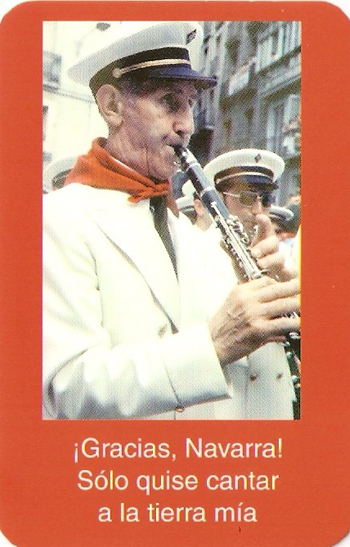
Fifteen years ago on October 20th 1997 one of the great Navarrans died. His name was Manuel Turrillas Ezcurra, and he was born in the village of Barrasoain , just under 25 km south of Pamplona. And beautifully, for those who know not just what the “Escalera” is, but the song too, he was born in 1905…on January 1st. Just perfect.
He is now known just as El Maestro Turrillas, because he really gave the modern fiesta as we know it now it’s beating, thumping, pumping heart. I mentioned him briefly in last month’s piece about the heavenly peña “La Veleta” but I thought it was about time I mentioned him more fully.
If you’ve ever woken up, say, on the grass in the Plaza de Castillo in the old town, and felt the earth moving, (steady!), or woken up in a flat and felt the walls pounding, you might quite possibly have been feeling the effects of your heart going into overdrive trying to keep you alive…or it could be that one of the peña bands was going past and playing one of El Maestro’s songs. Or both of the above, quite possibly…
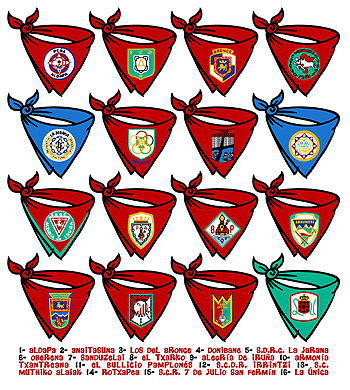
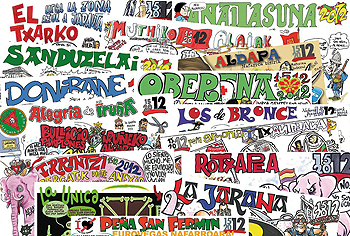
This amazing man was a true Pamplonican too, as he moved there when he was 20, and pretty instantly joined the town hall band, La Pamplonesa, where he stayed for 50 years. He wrote about 400 songs of all kinds, and some of those you will have heard and no doubt danced to during fiesta. Many of the peñas asked him to write their club hymn, and he also wrote the local football club’s song too.
And yes, he is honoured with a statue to him in his home town of Barrasoain, and they also put up a bust of him in a plaza named after him in a suburb of Pamplona, Berriozar, which was inaugurated in August 1998, but unfortunately it was stolen just a year ago and still hasn’t been found. Some people just have no learning or respect, actually, just no idea, and I hope at least once every day a pigeon in Pamplona poops on the perpetrators.
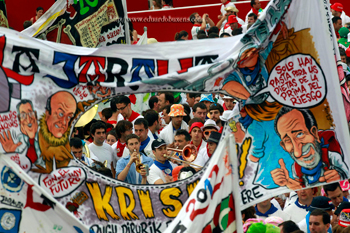
Now, just as I love the fact that he was born on January the 1st, there is something else that is rather touching. Maestro Turillas didn’t just live in Pamplona, but he lived in the Casco Viejo, the old town. And where would this man of Pamplona , of fiesta, who through his music will always live on, and has hence become an indelible part of San Fermin, live do you think? Well, there is a plaque marking where he used to live, in a street called La Cuesta de Santo Domingo. For those of you who don’t know, that is where the bull run begins.
And oh-so-perfectly, as so many of us know, before the encierro begins, a short refrain is sung three times to a replica of San Fermin that is put in the little niche in the old walls near the beginning of the run. Way back during my first fiestas I joined in singing that song, and my skin is tingling now as if it were just yesterday. The words go like this: “A San Fermin pedimos, por ser nuestro patron, nos guie en el encierro, dandanos su bendicion.” They have been singing this song before the run ever since 1962,and they also form part of the words to the club hymn of La Unica, formed in 1903 and the oldest of all Pamplona ’s peñas.
What do the words mean? Just this: “To San Fermin we ask it,as he’s our patron saint, guide us in the bull run and give us your benediction.” And why do I think it is “oh-so-perfect” that this particular song is sung on Santo Domingo Hill, where the maestro Turillas lived? Because he wrote the music to it. Sometimes, you just can’t improve the script or better the truth. I bet there is one happy man up in that great fiesta in the sky when he hears his song sung every July. What a musician, what a maestro, and by all accounts, what a lovely man.
The refrain sung to the saint before the run.
La Casa de la Misericordia
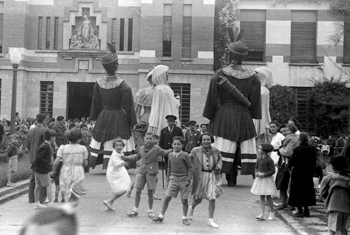
The word “misericordia” means forgiveness, pity…or mercy. The House of Mercy is an institution that has been going in Pamplona since 1706. It started out as a place that looked after the most “unfortunate” and “unfavoured” of the city’s inhabitants. Originally this included the young as well as the old, but it wasn’t until 1980 when they began to only look after old people who needed help.
But in 1920, when the town authorities decided to demolish the old bullring and construct a new one nearby, the rising costs effectively meant the town hall couldn’t afford to finance it, and eventually in stepped the Casa de Misericordia, who thanks to finance from various people and places in Pamplona to build the new Plaza de Toros became the de facto owners. Construction began in March 1921, and was speeded up when the old ring burnt down in August of that year, as they had to have a ring ready for the following year’s fiesta. And ready it was for its inauguration the following July 7th, 1922.
Ever since then this charity organises everything in relation to the bulls: the contracting of the ranches and the bullfighters, the setting up of the corrals where the bulls stay when they arrive in Pamplona,the arrival of the bulls into those same corrals, the setting up and construction of the wooden barriers that keep, hopefully, the bulls away from the watching crowds during the run, the shepherds (pastors) that run with the bulls and have saved so many runners from injury or worse, (as Alexander Fiske-Harrison pointed out to me, “shepherds” look after sheep…but I don’t know what other word to use – herdsman? Got it! ) and everything else you see or don’t see in the ring – the ticket collectors, bullring staff, the band, and even the butchery…the Casa de Misericordia looks after the lot.
James Michener and“The Drifters”
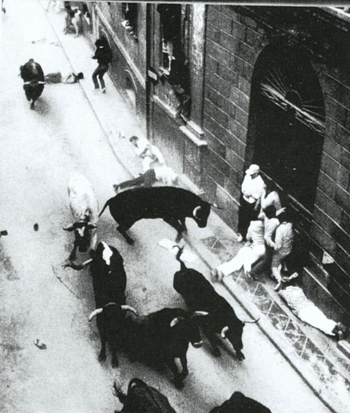
I thought it was about time I wrote my own little homage to a man I never met but who changed my life for ever, and for the better. And that is one of the most understated things I have ever written. This man didn’t just change my world, he introduced me to a whole new one. Pamplona , of course, and the Fiesta of San Fermin.
In 1980 I bought a book about a bunch of travellers at the tail end of the sixties, 3 guys and 3 girls from various countries, who meet up in Spain and decide to travel together. The first place they decide to go to as a group is Pamplona, during fiesta time. The Pamplona chapter is 100 pages long and quite frankly I just didn’t believe it. I knew the book was fiction, but this was just fairy tale stuff…surely, in this modern day and age a festival as medieval and crazy as what was described in the book just couldn’t exist? I knew one day I would go and find out.
Well, four years later with a friend I rode my Norton motorbike down through France, crashed the thing near the border, but made it to Pamplona by train. I still feel glad that I crashed…maybe I wouldn’t have arrived in Pamplona when I did, or chosen the corner of the Plaza del Castillo that I did…and hence met the people I did. But I tell you what, when I walked into the square on that July 6th afternoon, I knew I had found what I hadn’t even been looking for, a paradise on earth that still brings the goose bumps up whenever I think about it or whenever I am there.
Michener wrote many books, mostly fiction, but also a superb factual book called Iberia, packed with history and stories and photographs, and is well worth a read, especially if you love Spain. There is also his autobiography, “The World Is My Home.” But for The Drifters, I have to thank you James Michener, as my life has been immeasurably blessed by that one book.
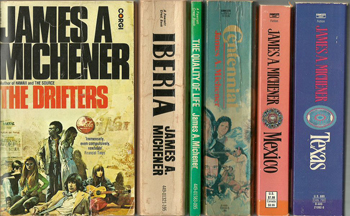
I could go on… thanks Hemingway, for influencing Michener, thanks Gertrude Stein for telling Hemingway…but really the thanks are due to Pamplona and it’s people, for turning a religious event into something that really is out-of-this-world…as I said near the beginning,what on earth would one of those other-worldly aliens make of this town and its inhabitants? I know what I made of it, and it changed my life for the infinitesimal better. Thank you Pamplona and Pamplonicans, I love you to bits, and as I wrote somewhere else recently…I blame the patxaran.
Monty Python
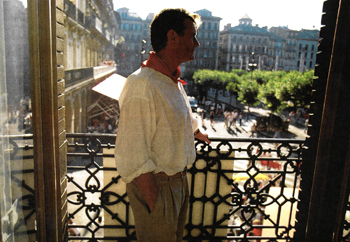
Oh, and Monty Python? Well, sort of, but not quite….but another “M.P.” for sure. And no, not my brother, Michael Pinks, but Michael Palin.
For those who don’t know, Michael Palin was part of Monty Python, but he was also a huge Ernest Hemingway fan. Ever since he was a boy growing up in the northern English city of Sheffield , he read Hemingway’s books and fell for this world outside his own that the great man wrote about. As he wrote in his book that accompanied a BBC travel series, “Hemingway Adventure,” after reading some of the man’s stuff, he felt like, he wrote, “I’d grown up a little. Lost my literary virginity. Books would never be quite the same again.”
He decided he would go out and experience Hemingway’s world, and that; “I must be bold and fearless and go out there and do it for myself.” He goes on to say; “Unfortunately in the 1950’s there wasn’t much call for provincial English schoolboys to carry mortars up Spanish hillsides, and though I had a goldfish I hadn’t fought for seven hours to land it.”
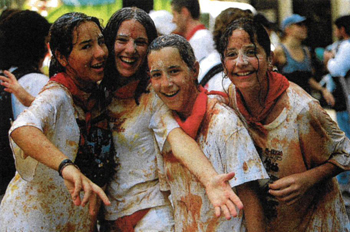
Decades later, and well after the Monty Python series and films were over, he has become a bit of a traveller, in fact a hugely entertaining, knowledgeable and funny one, who does wonderful and witty travel programmes for the BBC, and for the centenary of Hemingway’s birth in 1999, the Beeb, as we call them, sent him around the world following the writers path. And so it came to pass, of course, that he ended up in Pamplona during fiesta.
He stayed in the La Perla hotel in the square for the three days he was there, before having to move on and film more for the series, but he certainly caught the mood of fiesta. After all for those who know, those first three days are madness personified. Magic, marvellous and manic madness for sure and if you can only go for a few days, make it the beginning!
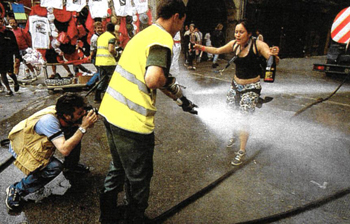
He didn’t do the run itself, but watched it from a balcony window in the hotel, but he did of course talked to people about it, including John Macho and James Ballor, always known as Curly. In the book, when he asks Curly about the run and why he did it and what he felt from it, one of the reasons Curly gives him is; “It’s an aphrodisiac, Michael. Believe me.” His reply? “Believe him or not, I can’t help thinking taking Viagra would be easier.”
“Michael Palin’s Hemingway Adventure” was a great series, and the book is a colourful and interesting travelogue through Hemingway’s life, written in Palin’s own simple, straightforward and inimitable style. It’s funny too. (He also wrote a funny novel called “Hemingway’s Chair”, for those of you interested.) But I’ll leave with this quote from the book of the series, before he watched his first run.
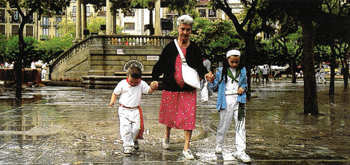
“There is not much rest to be had in Pamplona tonight. Those who have run with the bulls before will try to sleep as best they can. Those who haven’t will, likely as not, have been awake most of the night saucing themselves up. Those of us who are here to film have to be getting into positions on the course by six o’clock. And the noise goes on. It’s like the night before battle.” Two things I love in that paragraph…”saucing themselves up!” and “the noise goes on. It’s like the night before battle”. He got it!
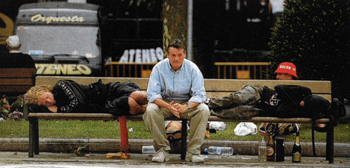
The Osasuna song
So, back to El Maestro Turillas for this months ending video, and let’s go from bulls…to balls. I mentioned he wrote the club song for the local football team, Osasuna, so here it is. There are many versions out there on the net of course, and of much better quality, but these guys in the band are my friends, and I love them to bits too. They are a Pamplona band, and used to be called Impekables, but are now Los Zopilotes Txirriaos. The song is “We’ll always be Reds.” But for some reason that night the words were changed to “We’ll always be guiris” (foreigners). Can’t imagine for the life of me why…the song starts after about 40 seconds. Remember, the music is The Maestro’s…

